|
Places of interest
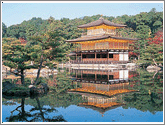 Kinkaku-ji Temple
Kinkaku-ji Temple
Kinkaku-ji is one of Kyoto's leading temples. Its formal name is Rokuon-ji. It was built at the end of the 14th century originally as a villa for Ashikaga Yoshimitsu, the shogun at the time. After Yoshimitsu's death, as indicated in his will, the building was converted into a temple of the Zen sect of Buddhism, which is famous for the practice of zazen, or religious meditation (a major method of Buddhist training, and method of meditation for establishing one's foundation in Zen Buddhism).
|
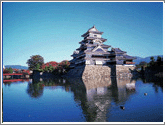 Matsumoto Castle
Matsumoto Castle
Matsumoto, situated almost right in the center of Nagano and known as the gate to the North Alps' climbing routes prospered as a castle town at the foot of Matsumoto Castle. The Castle's donjon that was built in 1615 is Japan's oldest existing donjon and is designated as a national treasure.
|
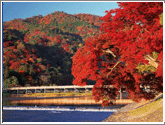 Arashi-yama
Arashi-yama
Arashi-yama is located in the western part of Kyoto. In the 8th century, aristocrats often came to this area of rice fields and bamboo woods to enjoy the scenery, or boating. The landscape today is still reminiscent of that period. Tenryu-ji Temple, a World Cultural Heritage Site, was erected in the 14th century by then Shogun Ashikaga Takau-ji, in a gesture of mourning for the Emperor. It is one of Kyoto-gozan or Five Major Temples of Kyoto and the garden is designated a special national scenic spot.
|
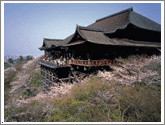 Kiyomizu-dera Temple
Kiyomizu-dera Temple
Kiyomizu-dera is one of the most famous temples in Kyoto and was built at the end of the 8th century. The main hall was constructed in the 17th century, and is famous for its location overhanging a cliff. The platform of the main hall, which is supported by 139 giant pillars, affords a spectacular view of the town of Kyoto. It is designated a National Treasure.
|
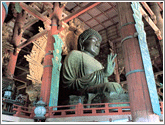 The Great Buddha of Todaiji
The Great Buddha of Todaiji
The Historic Monuments of Ancient Nara refer to the ruins, 6 temples and 8 primeval forests in the Nara City area. The 14.7-meter-high Great Buddha in the Daibutsuden (Great Buddha Hall) symbolizes Nara, and his pose of holding up the palm of his right hand to the front while placing his left hand on his knee with the palm upwards means that he gives strength to the people with his right hand while promising to grant their wishes with his left. The main body of the Buddha has been repaired many times over the years, but the lotus petal part used as the foundation and both legs are as they were when first made. The building, reconstructed in the Edo era, is the largest-scale ancient wooden building in the world.
|
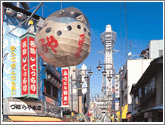 Osaka
Osaka
Osaka prefecture located in the center of Kinki region in the Midwest Japan covers the smallest prefecture land area in Japan, but boasts of largest population and highest population density second only after the capital, Tokyo. Mountains surround three sides of the prefecture and the west faces the arc-shaped Osaka Bay. Since it is close to former capitals of Japan Kyoto and Nara, it prospered as an important point for land and water transportation as well as a commercial city.
|
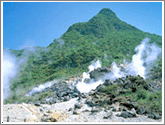 Hakone Owakudani
Hakone Owakudani
Owakudani is one of the most beautiful area as famous as the lake Ashi in Hakone.
You will enjoy the view of Mt. Fuji with Hakone mountains and also the volcanic landscape created 400 thousand years ago.
|
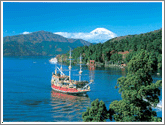 Hakone cruise
Hakone cruise
Hakone is the name that refers to the whole area, surrounding Mt. Hakone-yama that is situated in the southwestern part of Kanagawa, and is part of the Fuji Hakone Izu National Park. Hakone is an internationally well-known holiday resort that includes many renowned spas and Lake Ashino-ko, which was created by Mt. Fuji's repetitive volcanic activity. In Hakone, there are said to be "Hakone Thirteen Spas", or some even say "Hakone Seventeen Spas" altogether distinguished from each other by their distinctive ingredients and different healing effects.
|
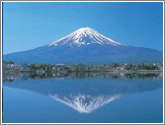 Lake Kawaguchi-ko
Lake Kawaguchi-ko
Lake Kawaguchi-ko is the easiest to get to from Tokyo and is the core of sightseeing in the Fuji-go-ko Lakes area. A classic style bus is runs along the lakeside carrying visitors to all the different museums and amusement facilities. Lake Kawaguchi-ko is also known as the starting point for climbing Mt. Fuji, as well as a Mecca for sports fishing.
|
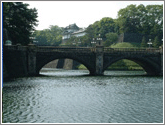 Imperial Palace
Imperial Palace
The Imperial Palace where their Majesties the Emperor and Empress live is situated in the center of Tokyo. The palace is surrounded by a water-filled moat and tree-covered grounds - a precious taste of nature within the city. "Kokyo Gaien (outer gardens of the Imperial Palace)", "Kokyo Higashi Gyoen (Imperial Palace East Garden)" and "Kitanomaru Park" are open to the public free of charge.
|
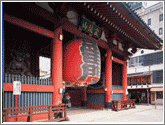 Kaminarimon
Kaminarimon
Located in Taito-ku along the west bank of the Sumida-gawa River, Asakusa once thrived as a temple town for Senso-ji Temple, and now it is a downtown that rivals with the Ginza, Shijuku, Ikebukuro and Shibuya. The history of Senso-ji Temple goes back far into the past. The legend has it that fishermen brothers discovered an image of Kan'non(the goddess of mercy) in the Sumida-gawa River around 1370 years ago and they were inspired to enshrine it. Its symbol is a large red paper lantern that bears the word "Kaminari-mon", or a thunder gate. There is a constant flow of visitors and worshippers throughout the year.
|
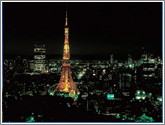 Tokyo
Tokyo
There are large scale downtown areas including the Ginza where all famous shops around the world stand side by side, Shijuku high-rise complex and its surroundings that never sleep, Asakusa with reminiscences of the traditional Edo(former name of Tokyo), and Shibuya that starts the trend for the young people as well as unique areas including the computer town Akihabara where electric shops are densely competing and attracting many shoppers from Japan and overseas and the Tsukiji open-air wholesale food market that serves all consumers in Japan.
|
|
















